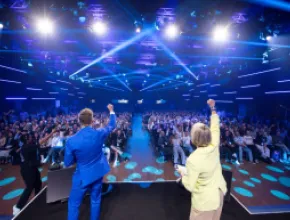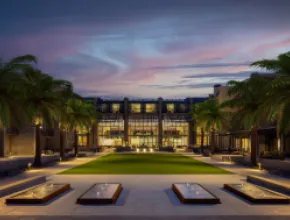Kyoto, on the western side of the main island of Japan, is a popular day trip from the nearby business center of Osaka and is only two hours by bullet train from Tokyo. But Kyoto is also a meetings destination in its own right, with an infrastructure that's ready for business and sites and activities that make it a must-see.
As the Kyoto Convention Bureau's James Kent notes, today's Kyoto appeals to high-end incentive programs and to groups that want to "go green" in a city that pioneered many environmental solutions to modern living--most observers agree that the United Nations Kyoto Protocol took environmentalism mainstream in 1997. Kyoto is also a center of academia in Japan, and regularly draws associations and professional groups.
And, Kent notes, "Kyoto makes a harmonious contrast with Tokyo for a multicity event."
Harmony is what it's all about. The ancient capital is the heart and soul of the land of “Wa,” a distinctly Japanese concept of harmony, beauty and cohesiveness. In a relatively compact, walking-friendly space, shoppers will find the latest fashions in a warren of covered pedestrian-only walkways that seemingly go on forever, gearheads can pick up the latest bleeding-edge electronics, and foodies will be happy to know that sophisticated Japanese cuisine fit for emperors was born here. Most of all, though, Kyoto is a city of temples and Japanese tradition.
The bigger temples standout--the Kiyomizudera temple complex is impossible to miss, perched on a hillside on the eastern edge of the city--but one of the pleasures of Kyoto is that by wandering on the smaller streets a visitor will almost certainly stumble upon a small temple. Once inside, more often than not a Buddhist monk or nun will offer you tea and invite you sit in their tranquil garden.
"It is very spiritual and also an aesthetically stunning city," says Miki Motegi, head of MICE in the Americas for the Japan Convention Bureau. "Kyoto is not just Japan's ancient capital for 1,200 years, but is such an international city. Kyoto has been welcoming guests from all over the world for decades, the same goes for MICE."
As a matter of fact, Kyoto is the city that the Japanese visit to get a taste of their country's past. A photo of a geisha on a cell phone is often used to show how ancient traditions still thrive in hypermodern Japan, and chances are this ever-popular tableau was photographed in Kyoto's Gion district, the center of historic gravitas in an already storied place.
Groups of geisha usually glide along in pairs in the Gion district, their colorful kimonos daintily held in one hand to keep them from dragging on the ground while the other hand holds a paper umbrella to keep their cherished pale skin safe from the sun. Even when holding their kimonos off the ground, their feet are often hidden and the women seem to hover more than walk.
Business Bonafides
The amenities and transportation infrastructure here is top-notch. A number of meetings large and small have called Kyoto home. In 2008 the city will host the G8 Foreign Ministers’ Meeting, and leading corporations--ranging from Hewlett-Packard to DHL--have staged incentives here.
Getting to Kyoto is a breeze thanks to nearby Kansai International Airport. A 10-hour flight from the West Coast of the U.S. and only three hours from most Chinese cities, a number of international airlines have direct flights to Kansai.
The airport, known by many travelers as KIX (pronounced "kicks") because of its airport code, opened in 1994 on a completely manmade island and has won design and engineering awards because of its forward-thinking construction techniques.
Numerous limousine buses run as regular as clockwork from KIX to Kyoto, and the drive itself takes the traveler through a patchwork of ultramodern bridges and scenes of Osaka city life. Rail service to Kansai is also a breeze--there are signs in English and the average Japanese citizen will go out of their way to help a confused traveler.
The city's meeting mainstay is the International Conference Center (ICC) Kyoto (www.icckyoto.or.jp" target="_blank">http://www.icckyoto.or.jp/en/charm/index.html). The first conference center in Japan, the biggest hall here can hold 2,000 people, and there are 70 conference rooms to accommodate meetings of all sizes.
With small ponds and gardens in the back, this has to be one of the most attractive conference centers in Asia--a whopping 70 percent of the area of ICC Kyoto is open space.
When it comes to hotels, there are 20,000 rooms in central Kyoto, with most of the business-friendly hotels within 15 to 20 minutes of ICC Kyoto. At the conference center itself is The Lodge, a 30-room facility often used by event organizers and meeting planners.
For an only-in-Kyoto sleeping experience, consider a "ryokan" traditional guest house, where attendees sleep on traditional Japanese beds and pad around their rooms in special robes. Many of these places are downright indulgent, with baths drawn for your attendees at the end of a long day and some of the most authentic cuisine Japan has to offer.
With so much culture and so many historic structures here, a planner is spoiled with choices. Would you prefer an off-site reception at Japan's oldest movie studio, or perhaps in a secluded hillside temple?
"The uniqueness of our country is contradiction; so rich in history but so modern, so subtle, but dynamic," Motegi notes. "Also, I like to stress that Japan being an expensive country is an old myth. Hotel rates even in major Japanese cities are very stable compared to other international cities where a one-night stay could cost $500 for a regular room. Considering that the Euro is very strong, Japan is even more attractive than before."





